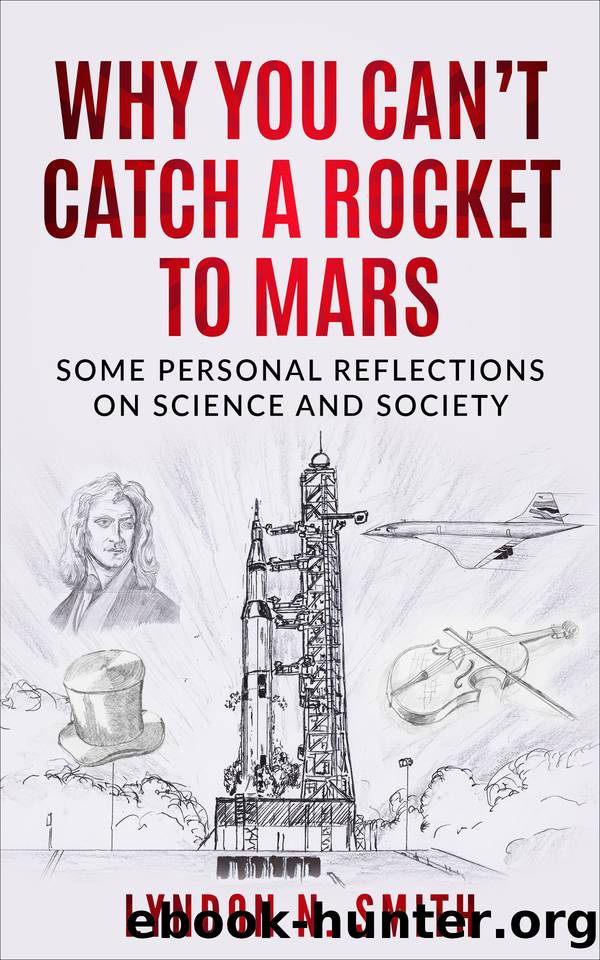Why You Canât Catch a Rocket to Mars: Some Personal Reflections on Science and Society, by Lyndon N. Smith by Lyndon N. Smith

Author:Lyndon N. Smith [Smith, Lyndon N.]
Language: eng
Format: epub
Tags: Non-Fiction, Science, Physics, Popula, Humor, Illustrated
ISBN: 9798566552750
Publisher: The Berkeley Bookstore
Published: 2020-12-01T13:00:00+00:00
Due to the extreme distance involved, if an ET were transmitting a signal to us it would need to be tremendously powerful and highly directional â and we would need to be looking for it at the exact right time â so the fact that such signals have not been verifiably detected does not indicate ETs do not exist. (Illustration by the author.)
This chapter is entitled contact with extra-terrestrials (ET) and the type of contact we have considered so far is that of communication by transmitted signals. But what about physical contact; what are the chances of an ET paying us a visit? We have noted how distant an ET exoplanet is likely to be located, so it follows that, considering the rudimentary nature of our spacecraft technology, the technology (and therefore the culture) of any ET capable of visiting Earth would be far in advance of ours. This may be why the noted physicist Professor Stephen Hawking considered the possibility of a visit from an ET lifeform to be a considerable threat:
"If aliens ever visit us, I think the outcome would be much as when Christopher Columbus first landed in America, which didn't turn out very well for the Native Americans."
- Stephen Hawking
On the other hand, Carl Sagan - physicist and all-round good egg that he was - was rather keen on the idea of alien contact. He even wrote Contact , which is a hard science fiction novel. The book, which appeared in 1985 and made the top 10 in the New York Times bestseller list, is concerned with contact between humanity and a more technologically advanced ET life form. In 1997, the book was turned into an enjoyable film starring Jodie Foster.
But Hawking was concerned that, in Earthâs history, when more advanced cultures come into contact with less advanced ones, the latter tend to suffer. He gave the example of when European explorers colonised the Americas, where the natives were pretty much devastated. And it is not just America; this pattern has been repeated over the ages over much of the globe. This consideration is what led Gene Rodenberry to create the Prime Directive for his fictional Starfleet . Gene was a futurist and a bit of a genius. He was also an optimist and envisaged a United Federation of Planets where beings on planets joined together in a cooperative union that was protected by Starfleet, with the latter comprising a fleet of starships (of which the USS Enterprise was one) and a network of star bases. His Starfleet is sworn to uphold the Prime Directive, which states: âThe Prime Directive prohibits Starfleet personnel and spacecraft from interfering in the normal development of any society, and mandates that any Starfleet vessel or crew member is expendable to prevent violation of this ruleâ. And, âAs the right of each sentient species to live in accordance with its normal cultural evolution is considered sacred, no Starfleet personnel may interfere with the normal and healthy development of alien life and culture.
Download
This site does not store any files on its server. We only index and link to content provided by other sites. Please contact the content providers to delete copyright contents if any and email us, we'll remove relevant links or contents immediately.
| Aeronautics & Astronautics | Astronomy |
| Astrophysics & Space Science | Comets, Meteors & Asteroids |
| Cosmology | Mars |
| Solar System | Star-Gazing |
| Telescopes | UFOs |
Turbulence by E. J. Noyes(7041)
Tools of Titans by Timothy Ferriss(6950)
Astrophysics for People in a Hurry by Neil DeGrasse Tyson(4620)
Room 212 by Kate Stewart(4108)
Pale Blue Dot by Carl Sagan(4003)
The David Icke Guide to the Global Conspiracy (and how to end it) by David Icke(3883)
Secrets of Antigravity Propulsion: Tesla, UFOs, and Classified Aerospace Technology by Ph.D. Paul A. Laviolette(3450)
Apollo 8 by Jeffrey Kluger(3201)
Losing the Nobel Prize by Brian Keating(3187)
A Journey Through Divination and Astronomy by Publishing Pottermore(3076)
Goodbye Paradise(2964)
COSMOS by Carl Sagan(2950)
Brief Answers to the Big Questions by Stephen Hawking(2878)
How to Read Water: Clues and Patterns from Puddles to the Sea (Natural Navigation) by Tristan Gooley(2857)
The Five People You Meet in Heaven by Mitch Albom(2843)
The Order of Time by Carlo Rovelli(2714)
How to Read Nature by Tristan Gooley(2666)
A Brief History of Time by Stephen Hawking(2474)
Aliens by Jim Al-Khalili(2382)
